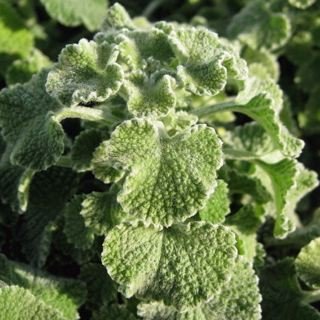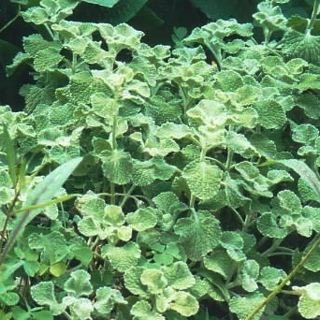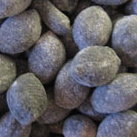





Not so long ago one of my students offered me a "new" cough drop. She said it was the newest thing in Europe and that it really stopped coughs. It was a small brown hard candy wrapped in a plain white square of paper, and with just one whiff I was engulfed in a bunch of memories.
There was a time when I faked so many coughs I made myself truly sick. I loved the taste of horehound, and when I was little we made our own cough drops. To me they were as good as any candy, and all I had to do to have one was to cough, so that's what I did. I knew if we ran out, we could make some more.
Horehound drops are hard to find nowadays, perhaps because their musky, bittersweet flavor is an acquired taste. Yet for a very long time this confection served as more than a mere candy. Horehound has a high mucilage content that soothes mucous membranes in the throat and respiratory passages. It has a long history as a medicinal herb, and can be traced back to ancient Egyptian medical practices.
Marrubium vulgare grows in dry soils, fields, and wastelands. It was introduced from Europe, and now grows wild in North America. It is an erect perennial with woolly whitish gray square stems up to about 3 feet high. Opposite, oval or round toothed leaves are downy and wrinkled., the lower leaves are long stalked. Small white flowers bloom in June through September and are borne in roundish clusters in the axils of the leaves. 
The plant is a source of flavoring for candies, teas, and syrups used in folk medicine as cold and cough remedies, however it was also used in other ways. Some 400 years before the birth of Christ, the famous Greek physician Hippocrates mentioned it in a work on infertility in women. The Roman naturalist Pliny, writing in the first century A.D., held horehound to be an herb of prime importance, listing a score of uses for it from laxative to an antidote for snakebite and other poisoning. The celebrated 16th century Italian physician and botanist Pietro Mattioli prescribed a horehound salve to increase nursing mothers' milk production. In North America during the 19th century horehound was administered not only for lung complaints but also for jaundice, dyspepsia, and hysteria.(1)
Even though pharmacologists who have studied the plant conclude that it is probably effective as an expectorant (a substance that helps bring up phlegm in respiratory passages) the United States Food and Drug Administration banned horehound from cough drops in 1989 due to insufficient evidence supporting its effectiveness. However, it is widely used in European cough remedies, and they continue to be sold in the United States. It is my understanding that it can be used as flavoring, but cannot claim to be of medicinal value in a product. Horehound also is effective as an appetite stimulant because bitters usually stimulate the stomach to produce acids that cause a desire to eat. If taken in large quantities it can also be a very mild sedative.
I realize the flavor of horehound is an acquired taste, and not always a popular one. I grew up during WWII, and there was not much candy available. Often the only sweet flavoring we had was the honey from my grandfather's bees. Having been born in the early 40's, it was a long time before I ever tasted store bought candy, and homemade candy of course, depended on whether or not we had the ingredients to make it. As luck would have it, my great Aunt Bett and my Granny Ninna both knew how to make horehound candy, in the guise of cough drops or lozenges, so it was always available. 
The traditional herb for making lozenges is horehound. It grew in sunny spots in the mountains, most often it came up in the same spot in the back of Aunt Bett's garden every year. We gathered the plant and dried it, then when the weather turned cold, this is what we did. We took the dried plant and poured boiling water over it, then we covered it and let it steep on the old wood stove in the kitchen. After it steeped for about 30 minutes, we strained it into a heavy saucepan, pressing with a wooden spoon to extract all the liquid. Then we added sugar and cream of tartar and stirred over very low heat till the sugar was all dissolved. We covered it then, and let it cook for 3 or 4 more minutes until all the sugar crystals had dissolved from the sides of the pan. The mixture was then cooked without stirring over high heat till it reached the hard ball stage (drop forms a brittle thread in ice water), then immediately we took it off the heat. We always had a marble slab that had been brushed with butter waiting, and we poured the mixture onto it. As it began to set, we scored it into small squares with a knife, then when it was cold, we cut along the lines. There were times when we did not have sugar, and honey was used in its place. Actually I liked the taste of honey better.
That made enough to last during the first part of the winter, those days when sore throats happened quite frequently. I timed my coughs to start right about then too, and when they never developed into a cold or sore throat, I had to just keep on coughing whenever I needed another taste of my favorite candy. 
I sure was glad when my student discovered that bag of European cough drops. I coughed a lot that day.
(1) http://en.wikipedia.org/File:Marrubium_vulgare
"Herbs for Health" The Magic and Medicine of Plants, page 437. The Readers Digest, Inc. 1986
The first photo is from Wiki's Public Domain, and the last is from the same source with appreciation to Raul654. The other photos are from Plant Files, thanks to Kell and Golddog.
Copyright © www.100flowers.win Botanic Garden All Rights Reserved